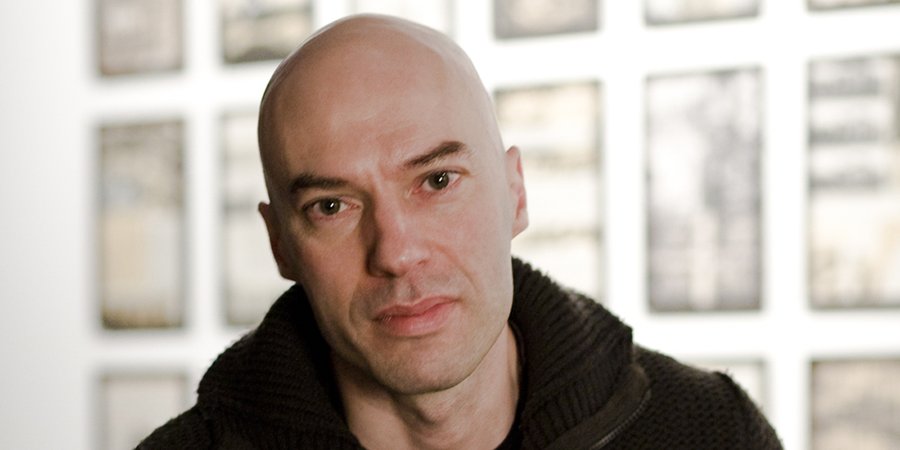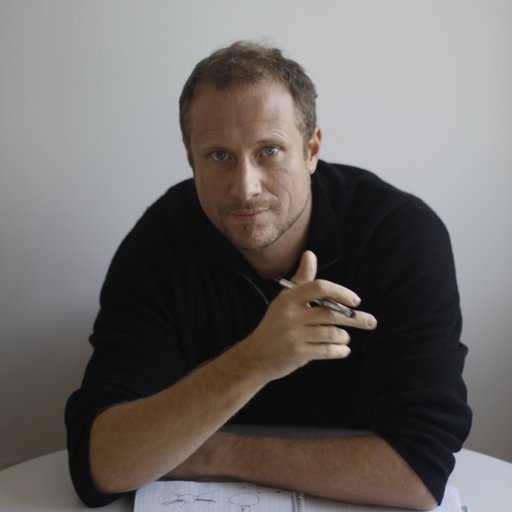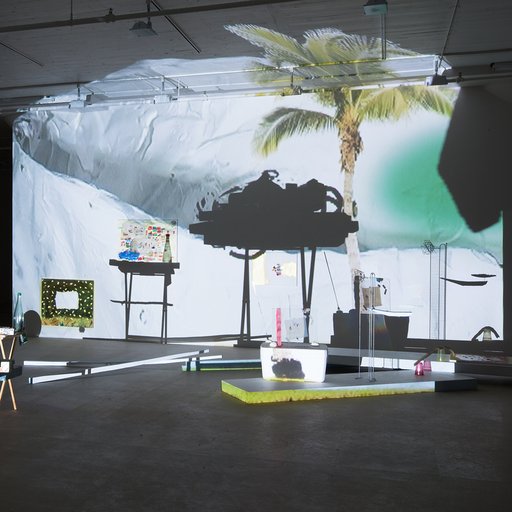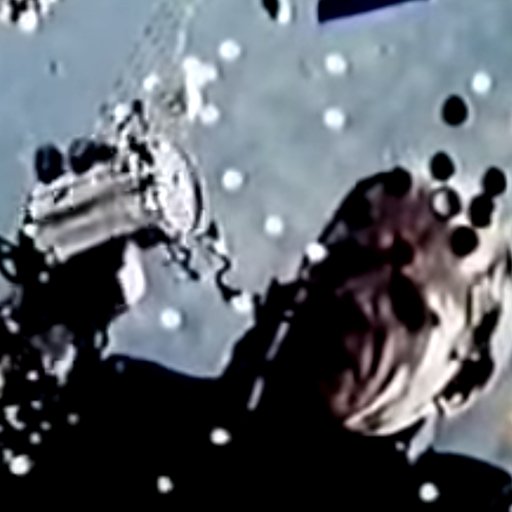A consummate art-world multitasker, Alfredo Cramerotti is, by his own admission, “incapable of doing one thing at a time.” He's currently directing the Welsh contemporary art gallery MOSTYN in addition to holding various curatorial, editorial, and institutional roles; earlier this year, he helped to curate the Mauritius Pavilion at the Venice Biennale.
He’s now turned his attention to EXPO Chicago’s EXPO VIDEO section, where he has selected works by both established and lesser-known artists based on the theme (and show title) “Futuro Anteriore” (Future Perfect). As the press release states, the phrase refers to the grammatical tense that expresses “events, experiences, and facts that are considered, but remain part of the future.” The works themselves explore and expand on this idea through the moving image, reflecting forward-thinking experimental tactics as well as more familiar aspects of filmmaking; represented artists and galleries include Chris Burden (Massimo De Carlo), Carolee Schneemann (Hales Gallery / P.P.O.W), and Christian Jankowski (Lisson Gallery). Artspace's Dylan Kerr caught up with the busy curator to discuss making videos for creatures other than humans, designing a video exhibition with a viewer’s sore feet in mind, and what Iggy Pop has to teach us about the art market.
Your 19 selections for the EXPO VIDEO section cover a huge range of approaches to the moving image, including works by video art giants like Carolee Schneemann as well as Columbia College Chicago Film and Video students. How did you select these pieces and artists, and what is the curatorial conceit that binds them together?
In selecting these pieces, it was important to me to take the temperature of the visual culture through the moving image. I consider myself quite an eclectic curator. I curate exhibitions, but also conferences, symposia, online projects, books, and so on. I’m less concerned about presenting emerging artists or younger artists—it’s more about trying to create a context that is built with the viewer in mind as well as the artist. The age of the artists in EXPO VIDEO goes from 20 to 70, and you have masters like Chris Burdenalongside very young and almost obscure artists.
EXPO VIDEO is really about trying to understand the overlap between experimental video art and more traditional, classical filmmaking. The works were selected with these ideas in mind, to try to spot those artists that actually cross boundaries. Maybe they use experimental techniques in terms of video making, editing, or camera work, but then they apply that to a very traditional type of cinematography or cinematic aesthetics. Conversely, there are also artists embedded into traditional filmmaking—using the genres of Hollywood films like the epic journey, the mystery, the crime story, or whatever—but translating that into a more free form, experimental type of narrative. I wanted to pick artists and those artworks that are actually on both sides—experimental but also very involved in the aesthetics of cinematography, or making traditional cinematic narratives with a very experimental take.
Where does the exhibition’s title, “Futuro Anteriore” or “Future Perfect,” come from?
The constant back-and-forth between the idea and the form in these works is extremely interesting to me, hence the exhibition’s title. It’s almost a paradox, because it describes something that it will happen in the future but is based on the premise of something that has happened already. There’s a tension between the present, the past, and the future in these pieces, and I see it as the same paradox that applies to these artists that are working in both areas of visual culture, in both experimental and traditional filmmaking.
It’s this idea that helped me to select these examples out of a huge number of artists. If you think about it, there are about 140 galleries in EXPO Chicago, and each gallery probably has an average of 15 artists. Not all are working with the moving image, obviously, but there are actually quite a number of artists for whom the moving image is at least a part of their work. It has been quite a long process of going through all the artists’ portfolios and the obscure links to obscure festivals where an artist once showed. With some of the artworks we have in the show, I actually remembered them but I couldn’t find them online, so I had to contacted the artist or the gallery like to see if there was any way to find it. It was a long, interesting process.
You’re no stranger to curating exhibitions—EXPO VIDEO marks your 6th show this year alone, including the Mauritius Pavilion at the Venice Biennale—but I wonder how your approach changes when presenting works in a commercial context like an art fair.
This isn’t the first time I’ve curated a show in a commercial setting. Usually, it happens when an artist that I’ve known for a long time or that I respect is having a solo show and his or her gallery asks me if I could help set it up. To be very honest, I think the most important thing is to not forget that art implies a huge number of things and approaches. You have to think about the process of conceiving or creating the work, about the display of the work, and about the mediating to the public, but you also have to think about the collecting of the work, the buying and selling of the work.
In an art fair, I think it’s crucial to understand where the value of an artwork comes from. It’s important to be aware of the value and the potential for growth of an artwork, both in terms of cultural importance and maybe even investment potential. It doesn’t live inside of a vacuum. It starts with the practice of the artist, with including putting shows in dialogue with their peers, and maybe curators and institutions as well. There’s a constant flow of influence.
I always remember what Iggy Pop said in the John Peel lecture he did last year, something to the effect that “capital always follows actions.” That’s a pretty good way to put it—there is always going to be a substratum that art comes from. It can be art school, but it can also be through dialogue with her or his peers, through exhibiting in a group show, a solo show, a non-profit organization, an institution, an academic organization, whatever. All this happens more or less accidentally, and then, somehow, it goes to the market where it is ascribed value. The value is not generated because someone decided it has a value, though—it’s generated well before, actually. To me, to curate in a non-profit context or in a commercial context represents two sides of the same coin. I am quite OK with doing either, because I recognize the importance of both.
One of the problems when working with new media and especially moving images is the simple challenge of getting people to stand or sit in one place long enough to actually take in the work. How do you solve this problem of captivating an audience that is perhaps only passing through, both in general and in the context of EXPO Chicago specifically?
To me, the idea is to really bring the viewer to the center of the experience, so when I curate an exhibition I always put myself in the viewer’s shoes. Video and film exhibitions are one of the most difficult types to build, because they are time consuming—they force people to stay there. They can be quite uncomfortable as well—it’s an exhibition setting rather than a cinema, so viewers might be standing. Looking at it from the viewer’s standpoint, I ask myself, “When I go into an exhibition and I see there are a number of video works, do I want to tackle the video works first or have a look at the other pieces and then come back? How long does it take? Where will I stand?” I may have these questions on my mind as a result of my institutional role as director of MOSTYN. When you are running an institution in dialogue with the audience on a constant, daily basis, the viewer’s experience becomes quite important.
In a nutshell, I try to differentiate the type of experience. For this year’s EXPO VIDEO, I asked Tony Karman for two screening rooms. Previously the video program was shown through viewing pods, which are actually gigantic LCD screens. There are four of them in the middle of the space. I said, “OK, we can use them, but there are some works that are going to need a different type of setup.”
I was able to build two new purpose-made screening rooms to show some of the selections, and the four viewing pods show one work each. For the pods, I chose works that don’t have to be experienced sitting down in darkness—you get can get a glimpse of them passing by or just standing in the middle of the space. They grasp you, and they don’t leave you even if you only see five seconds of them.
Curating a show like this is a matter of shaping different experiences for the viewer, because not every work is supposed to be experienced in the same way. Artists are the first to say, “I would like the work to be experienced in such-and-such a way,” but the viewers may experience the work in a totally different way than the artist imagined. I want to open up a bit of possibility, to try different ways of creating a film and video program beyond the cinema screening. It’s a free-floating type of viewing experience, because these four pods will supplement the two new screening rooms.
Can you tell me more about those viewing pods, which were designed by the Studio Gang Architects?
The pods are really just sections of wall with huge screens embedded, set up opposite to the screening rooms with a central space—an agora, if you like—where people can mingle. I think the pods are great, because they are quite striking as pieces of indoor architecture while also providing excellent resolution for the viewer. They are for works that you don’t have to sit down to experience—I would actually say that it is better to encounter these works by walking past them and getting caught. The structure of the screens is quite effective in doing just that.
How does a medium-bending work like Stan Douglas’s “interactive art app” Circa 1948 fit into a film and video program?
I wanted to try to go beyond the normal film or video for this exhibition. Stan Douglas has made a fantastic app—really, a piece of art. It’s about postwar Vancouver, and it’s partly autobiographical because Douglas is from the city himself. Circa 1948 is really a viewing experience, because you actually move through the streets of Vancouver in 1948 in a kind of psychogeographic tour. You can hear voices, but there’s not much going on. It’s more about building the story in your own head as you go through the streets.
When I first downloaded it on my phone and tried to use it, I found that it was quite addictive, so I tried a kind of experiment. I passed it on to my nine-year-old son, and he got hooked as well. He took it as a game, and it got to the point where he would beg me to use my phone so he could play the game. I thought this was a great sign, because that’s exactly what a moving image is supposed to do. It’s supposed to capture you, to envelope you and bring you into a narrative so that you project some of your own story onto the artwork. In a way, the function and the result were quite similar. If it has the same effect that it had on my son, I think it’s a great, great work of art.
I decided that I wanted this work in the film and video program even though it’s an app. We came up with the idea to present it on a number of devices with a QR code, so you can download it on your phone. The app itself is free, so you can download it and play it at home. If it works here in Chicago, if the viewer experience is great and the audience is responding well, I can think of all kinds of developments we can make with this as a kind of a pilot. Aesthetically, it is right in the center of the curatorial idea while also representing a structurally different experience, and I am really keen to experiment with this structure and see what happens.
What other works in this show stick out to you as examples of the curatorial theme?
All of them, really [laughs]. There’s a masterpiece like Carolee Schneemann’s Fuses, for instance, an autobiographical work that shows her and her partner having sex from the point of view of her cat. It’s not pornographic—you see a mixed blur of colors and suffused images, with glimpses of shapes and bodies. Sometimes the camera goes around and you see at bit of the floor. It has a kind of third-eye perspective, not from another human but from her cat. It’s beautiful, because it’s something that is atemporal, in a way. It is not only about humans—it’s about every type of creature, including us, going through that experience. Part of its beauty comes from not having any superstructure imposed on it.
Another piece that comes to mind is The Winchester Trilogy by Jeremy Blake. We’re showing an abridged, five-minute version called The Winchester Redux. It’s about the house of the Winchester family, which they built in California. The widow of the heir to the Winchester rifle company was haunted by what she believed were the ghosts of the people killed by rifles that her father-in-law invented. She went to a psychic, who told her that the only way to keep these ghosts away was to create noise and to always have people in the house. For more than 50 years, she commissioned work on the house—rooms added to rooms, additional doors and windows that were then taken out, staircases that led nowhere. In the end, after these 50 years, the house had become a crazy, totally utopian architecture, where you don’t have any sense of the living space.
In both of these examples, you have an overlap between a traditional sense of film and the subgenre of experimental video culture—Scheenman’s work is a love story, for instance, but in a very novel way, and Blake’s Trilogy is really a cinematic landscape of a house explored through unconventional means. These two modes integrate seamlessly here.
You’re also including two works by students from Columbia College's Film and Video program. How did you settle on these two pieces? What do they bring to the exhibition?
EXPO VIDEO is produced in collaboration with Columbia College, and they submitted about 12 or 15 works from filmmakers in their graduating class—which is where I got these two. I chose them because they have quite strong narratives. They are more indebted to the classical cinematographic narrative—they have openings, three-point story arcs, and conclusions—but the stories themselves are quite experimental. They offer two windows, so to speak, into what’s going on in film right now.
To conclude, I want to talk about your work ethic. In addition to your work at EXPO Chicago, you’re involved in slew of other art world organizations, initiatives, and projects, including directing MOSTYN in Wales and writing/editing several books. What do you see as the connection between all these endeavors—your writing, curating, directing, organizing, et cetera?
I think they all inform each other. I have to say that, although I’m quite old [laughs], I think that my mind works very digitally. I’m kind of incapable of doing only one thing at a time. I always switch from one thing to another—that's my way of working. I go from writing to curating a show to giving a tour to having a meeting, and I’m comfortable constantly switching from one to the other. To me, it’s much more productive.
At the beginning of my career, I thought that I should concentrate on one task at a time. To me, this actually drains energy. I really get energy by doing different things. The activities of editing a book series, curating a show, and running an institution actually feed into each other, and that’s where I get the energy and drive to go out and do more.























